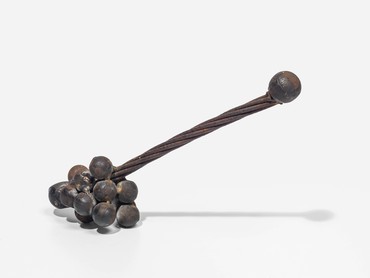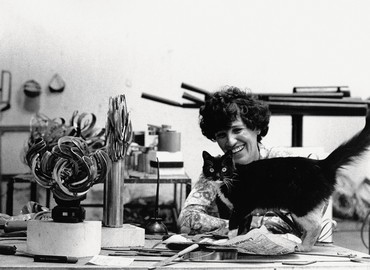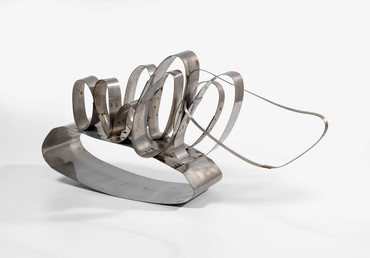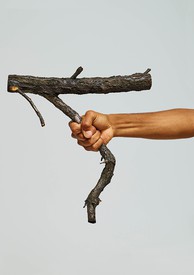
Salomé Gómez-Upegui is a Colombian-American writer and creative consultant based in Miami. She writes about art, gender, social justice, and climate change for a wide range of publications, and is the author of the book Feminista Por Accidente (2021).
Feliza Bursztyn’s entire existence defied the status quo. A key figure in Colombian modernism, she pushed the boundaries of kinetic sculpture and pioneered the use of found materials and multisensory installations. Describing herself as “a welder and a worker,” she also championed feminist and leftist political views in direct defiance of Colombia’s conservative and Catholic society.
The daughter of Polish-Jewish immigrants, Bursztyn was born in Bogotá in 1933. Her lifelong love affair with the Colombian capital lasted until the end of her days. Her father’s small textile business afforded her the rare possibility of moving to New York, at the age of eighteen, to study at the Art Students League. At twenty-four, divorced with three children, she moved back to Bogotá to pursue her dream of becoming an artist, leaving her children in the care of their father.
In response to Bursztyn’s defiant lifestyle, the Colombian press often referred to her as “la loca” (the madwoman), a moniker that she gleefully embraced and made her own. In an interview with Carrusel magazine in 1979, entitled “En un país de machistas ¡hágase la loca!” (In a sexist country, pretend to be a madwoman), Bursztyn said, “I took advantage of the crazy thing and insisted on it to really do what I wanted because I do believe that we live in a macho world. And being a sculptor and not being a man is very difficult. In order for people to take me seriously, I resorted to that trick, because they thought, ‘Maybe that madwoman does interesting things.’ And I think it worked.”
Bursztyn’s series Las Histéricas (The hysterics, 1967–69) exemplifies her willingness to embrace insults as flattery and to transform hostility into art. Built from thin steel strips salvaged from a local factory, these tantalizing circular forms vibrate to no beat in particular with the help of small motors, emitting an unsettling mechanical noise. They question sexist medical codifications of women and they rattled viewers to the core.
Bursztyn lived and worked for over twenty years in a garage next to her father’s factory, having converted the structure into an eccentric three-story home/studio with the help of Colombian architects Rogelio Salmona and Carlos Valencia. She famously hung pictures of Fidel Castro and Che Guevara in her workspace and often held cultural soirées there for a wide array of journalists, writers, poets, filmmakers, musicians, and artists. “And this is my house, full of old irons, spot welders, transformers, paints, scrap metal, cats, dogs, flowers, seeds. Of course, there’s also a kitchen,” the artist says, laughing, in the short film Las camas de Feliza (The beds of Feliza, 1974), produced by the Spanish filmmaker José María Arzuaga.
It is impossible to understand the trajectory of Bursztyn’s career without considering her proximity to key figures of Colombia’s artistic and literary scene. She had a romantic relationship with the illustrious Colombian poet Jorge Gaitán Durán, with whom she moved to Paris in 1957 to study at the Académie de la Grande Chaumière under the Russian sculptor Ossip Zadkine. “You know, if I’m a sculptor it’s thanks to Jorge,” she once said.1 Bursztyn was also close to the eminent Colombian artist Alejandro Obregón, whom she lovingly called “la madre” (the mother), and was a dear friend of renowned art critic Marta Traba, who rarely missed an opportunity to defend the extravagant artist from the endless waves of criticism that swelled her way. The novelist Gabriel García Márquez, his wife Mercedes Barcha, and the journalist Enrique Santos Calderón were all in her inner circle.
To say that Bursztyn lived and died surrounded by friends is not hyperbole. García Marquez, Barcha, Santos Calderón, and her then husband, Pablo Leyva, were all present when she suffered a heart attack in a Paris restaurant at the age of forty-nine. In an article he wrote about the tragedy, “Los 166 días de Feliza” (Feliza’s 166 days, 1982), García Marquez said that Bursztyn had died of pure sadness. Exactly 166 days before her death—following two trips to Cuba—she had been arrested and tortured by Colombia’s military under the suspicion that she had a connection with the leftist Colombian guerrilla group M-19. This led her to seek political asylum in Mexico and then to move to France, where she died less than six months later.2
During Bursztyn’s lifetime, her work was rarely seen internationally. She participated in just a handful of exhibitions abroad, in countries such as Cuba, Poland, and Israel, and on her premature death, most of her sculpture lay in Colombian institutions or private collections. Over the years, a few of Burstyn’s pieces have been featured in group shows at Tate, London, and the Museum of Modern Art, New York, and she was included in Radical Women: Latin American Art, 1960–1985 at the Hammer Museum, Los Angeles, in 2017. Even so, the international art world is only beginning to scratch the surface of her genius.
Feliza Bursztyn: Welding Madness, the artist’s first retrospective outside Colombia, arose precisely as an attempt to introduce her to the global art world. Cocurated by Abigail Winograd and Marta Dziewańska, this expansive exhibition features around fifty sculptures, installations, films, and archival materials, most of them never before shown in Europe. It presents her as one of Latin America’s most important sculptors of the twentieth century. Bursztyn “refused to be normal,” Dziewańska says. “She would not be squared into how female artists should work. And that’s why we gave the exhibition the title ‘Welding Madness,’ because she was daring to go in the direction of what is seen as abnormal, what is seen as extravagant, what is seen as female excess.”3
Feminist politics are always present in Bursztyn’s work. Her desire to touch on prohibited subjects is clear in her series Las Camas (The beds, 1974), which debuted at the Museo de Arte Moderno de Bogotá (MAMBO). A group of thirteen metal bed-frames furnished with electric motors and covered by vibrantly colored satin sheets, the sculptures moved suggestively against the sound of an ominous electro-acoustic beat written for the occasion by the Colombian composer Jacqueline Nova. The work brought Colombian society face-to-face with unspeakable eroticism, illustrating once again the artist’s undeniable talent in creating discomfort and defying hegemony.
Bursztyn’s renewed relevance, more than forty years after her passing, is a testament to her avant-garde nature. Since the intransigent society she so fiercely sought to convulse is alive and well, her art remains as pertinent as ever. Referencing her brilliance in Colombia’s traditionalist society, Traba once wrote, “Many times Feliza has passed as a rebel without a cause, and this is a true injustice. All of her acts of aggression against established models are born from the same desperate desire to shake up the environment, dust it off, exasperate it. They are born, of course, out of love for the environment and her furious desire to change it.”4
1Feliza Bursztyn, in Juan Gustavo Cobo Borda, “Entrevista trunca con Feliza Bursztyn,” Cromos (Colombia), March 8, 1983.
2Gabriel García Márquez, “Los 166 días de Feliza,” El País (Madrid), January 19, 1982.
3Marta Dziewańska, Zoom conversation with Abigail Winograd and the author, March 8, 2022.
4Marta Traba, “Feliza Bursztyn: Imaginación en escultura,” El Tiempo (Colombia), September 19, 1974.















